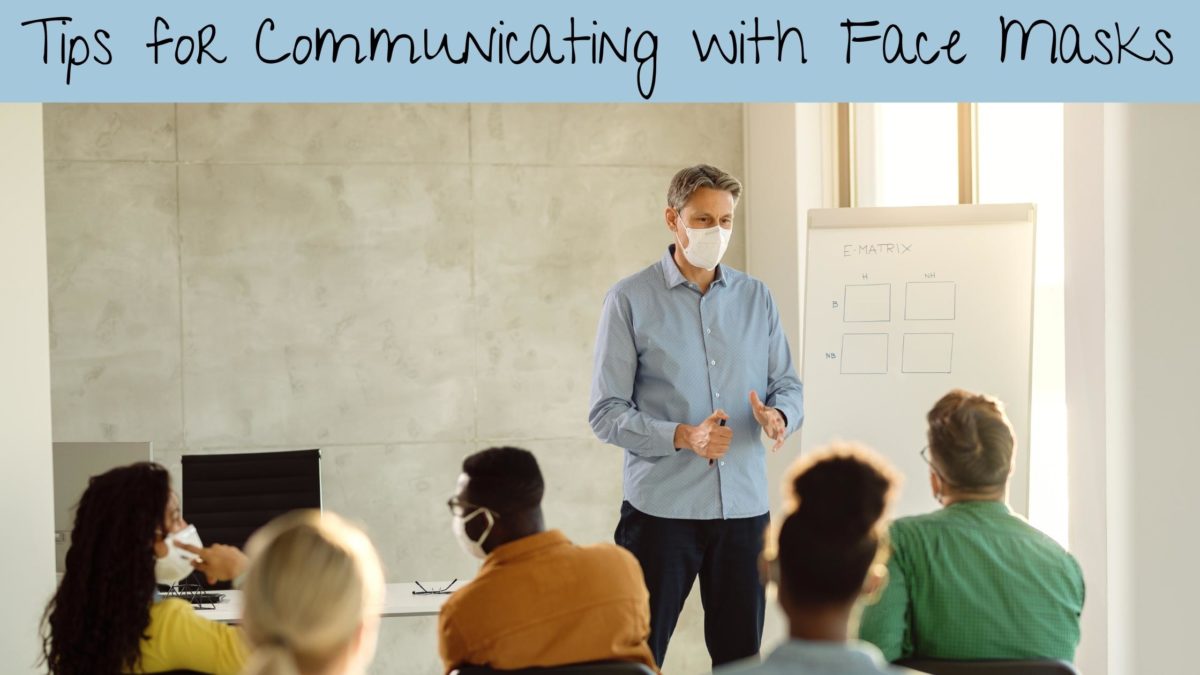With the Covid-19 pandemic happening, many of us are wearing masks and observing six feet of “social distance.” Experts say this is important to reducing the impact of the pandemic, though it poses some difficulties for everyone. Especially for those with hearing loss and other communication issues, masks and distance are among the very things that we would recommend not to employ while communicating, under normal circumstances.
Difficulties Posed By Masks
- Muffled Sound – Hearing loss tends to roll off the high frequencies that are important for understanding speech. While even those with normal hearing may have difficulty understanding some people’s speech while some types of mask are worn, those with hearing loss will have extra difficulty.
- Blocking Mouths – Those with hearing loss frequently rely to some degree on lip-reading to help augment the sound they do hear. Of course, we can’t see a person’s mouth while they’re wearing a facemask.
- Blocking Faces – Depending on the sizes and types of mask, usually more than just a person’s mouth is blocked. We may not be able to see as much jaw and cheek movement, and may have very little but a person’s eyes to help communicate. Masks have helped many of us, both with and without hearing loss, to realize just how much we normally rely on all the visual cues from a person’s face in order to communicate.
- Masks Can Be Hard to Wear With Hearing Aids – Especially for those wearing BTE (behind-the-ear) models of hearing aids, the strings that attach masks behind our ears conflict with the position of our hearing aids. Some types of ITE (in-the-ear) models can also be less comfortable when our ears are being pulled forward by mask strings.
How To Make Masks Less Difficult
- Clear Panels – Some people have been making masks with clear panels sewn in to reveal the wearer’s mouth. Of course, it’s more important that people with normal hearing wear these than for people with hearing loss, but it’s still a good idea for those with hearing issues to wear them to get others used to the idea.
- Button Extender – If looping the mask behind your ears is difficult, you can use a button extender to clasp the ear loops behind your head instead.
- Wig Tape – If masks are moving your BTE hearing aids around, use a little wig tape to secure the BTE unit in place.
- Different Masks – Some masks have four strings instead of ear loops, so you can tie them in two places behind your head to secure them in place and leave your ears untouched.
- Other Barriers – Is there a way you can perform whatever activity you’re doing without using a mask? Maybe a plexiglass barrier or face shield would work instead of a mask.
Difficulties Posed By Social Distancing
- Desired Sound Is Quieter – The further we get from a sound source, the quieter it becomes. Every doubling of distance poses about a -6dBA drop in volume. If we’re already having difficulty with hearing speech at a normal distance, putting a mask on the speaker and moving them to a distance of six feet is a significant obstacle.
- Background Noises Are Effectively Louder – Background sounds will become more significant in relation to the speech we are trying to hear. While we may be relatively distant from sources of noise, moving a speaker away from us while background noise stays the same is effectively the same as making the background noise louder. Even hearing aids that are capable of differentiating between speech and background noise may have difficulty when distance and masks come into play.
- Visual Cues May Be Lost – Reading facial expressions and mouth movements also becomes more difficult with distance, even if they are not obscured by a mask.
How To Make Social Distancing Less Difficult
- Make sure you face the person you’re speaking with.
- Speak a little louder and slower.
- Try to use your hands and body language more.
- Pause after statements to make sure they’ve been heard, and nod visibly to affirm that you have heard the other person.
- Move away from areas with a lot of background noise, if possible.
- Ask the person you’re communicating with if there’s anything you can do to make communication easier for them.
Get a Hearing Test
If you’re due for a hearing test, you should make an appointment and get one soon. The Better Hearing Institute, a non-profit, recommends getting a hearing test once every decade until age 50, and once every 3 years after that. Not everyone who has a little hearing loss needs hearing aids, but a hearing test allows a professional to advise you on whether your hearing is normal for your age or if there are things you could be doing to better protect your hearing health going forward.

